2004 ISUZU TF SERIES service
[x] Cancel search: servicePage 81 of 4264
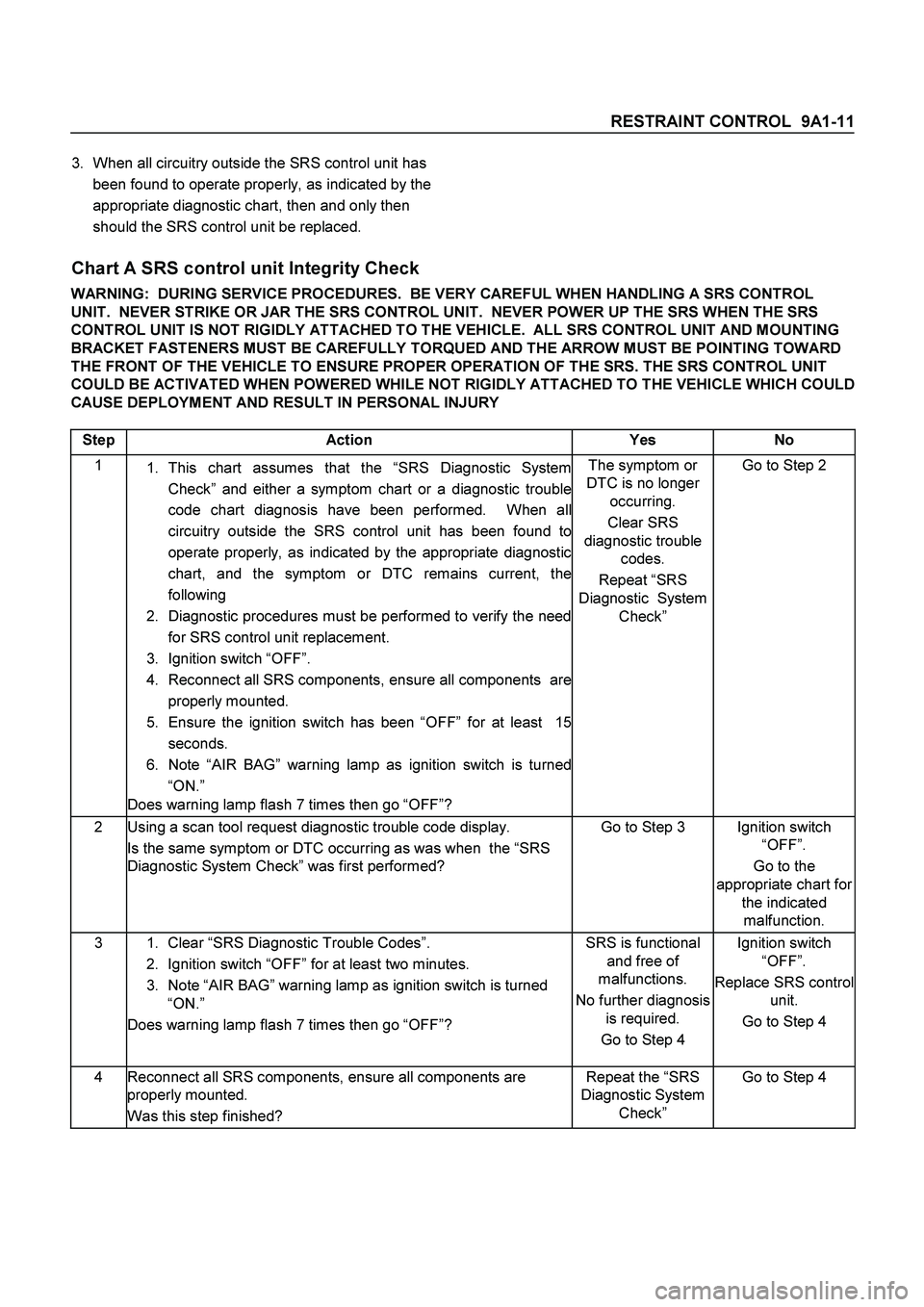
RESTRAINT CONTROL 9A1-11
3.
When all circuitry outside the SRS control unit has
been found to operate properly, as indicated by the
appropriate diagnostic chart, then and only then
should the SRS control unit be replaced.
Chart A SRS control unit Integrity Check
WARNING: DURING SERVICE PROCEDURES. BE VERY CAREFUL WHEN HANDLING A SRS CONTROL
UNIT. NEVER STRIKE OR JAR THE SRS CONTROL UNIT. NEVER POWER UP THE SRS WHEN THE SRS
CONTROL UNIT IS NOT RIGIDLY ATTACHED TO THE VEHICLE. ALL SRS CONTROL UNIT AND MOUNTING
BRACKET FASTENERS MUST BE CAREFULLY TORQUED AND THE ARROW MUST BE POINTING TOWARD
THE FRONT OF THE VEHICLE TO ENSURE PROPER OPERATION OF THE SRS. THE SRS CONTROL UNIT
COULD BE ACTIVATED WHEN POWERED WHILE NOT RIGIDLY ATTACHED TO THE VEHICLE WHICH COULD
CAUSE DEPLOYMENT AND RESULT IN PERSONAL INJURY
Step Action Yes No
1
1. This chart assumes that the “SRS Diagnostic System
Check” and either a symptom chart or a diagnostic trouble
code chart diagnosis have been performed. When all
circuitry outside the SRS control unit has been found to
operate properly, as indicated by the appropriate diagnostic
chart, and the symptom or DTC remains current, the
following
2. Diagnostic procedures must be performed to verify the need
for SRS control unit replacement.
3. Ignition switch “OFF”.
4. Reconnect all SRS components, ensure all components are
properly mounted.
5. Ensure the ignition switch has been “OFF” for at least 15
seconds.
6. Note “AIR BAG” warning lamp as ignition switch is turned
“ON.”
Does warning lamp flash 7 times then go “OFF”? The symptom or
DTC is no longer
occurring.
Clear SRS
diagnostic trouble
codes.
Repeat “SRS
Diagnostic System
Check” Go to Step 2
2 Using a scan tool request diagnostic trouble code display.
Is the same symptom or DTC occurring as was when the “SRS
Diagnostic System Check” was first performed? Go to Step 3 Ignition switch
“OFF”.
Go to the
appropriate chart for
the indicated
malfunction.
3
1. Clear “SRS Diagnostic Trouble Codes”.
2. Ignition switch “OFF” for at least two minutes.
3. Note “AIR BAG” warning lamp as ignition switch is turned
“ON.”
Does warning lamp flash 7 times then go “OFF”? SRS is functional
and free of
malfunctions.
No further diagnosis
is required.
Go to Step 4 Ignition switch
“OFF”.
Replace SRS control
unit.
Go to Step 4
4 Reconnect all SRS components, ensure all components are
properly mounted.
Was this step finished? Repeat the “SRS
Diagnostic System
Check” Go to Step 4
Page 85 of 4264
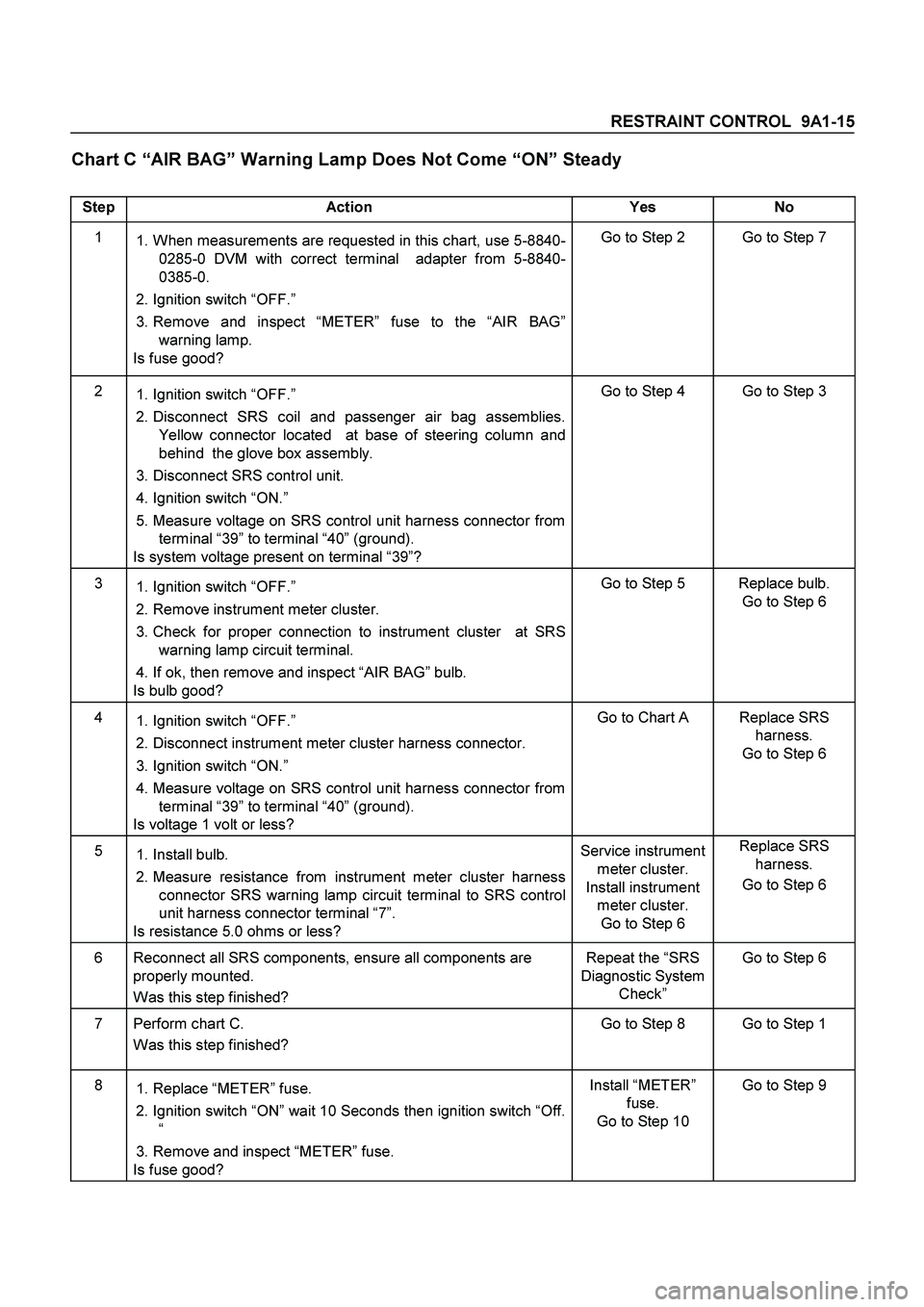
RESTRAINT CONTROL 9A1-15
Chart C “AIR BAG” Warning Lamp Does Not Come “ON” Steady
Step Action Yes No
1
1. When measurements are requested in this chart, use 5-8840-
0285-0 DVM with correct terminal adapter from 5-8840-
0385-0.
2. Ignition switch “OFF.”
3. Remove and inspect “METER” fuse to the “AIR BAG”
warning lamp.
Is fuse good? Go to Step 2 Go to Step 7
2
1. Ignition switch “OFF.”
2. Disconnect SRS coil and passenger air bag assemblies.
Yellow connector located at base of steering column and
behind the glove box assembly.
3. Disconnect SRS control unit.
4. Ignition switch “ON.”
5. Measure voltage on SRS control unit harness connector from
terminal “39” to terminal “40” (ground).
Is system voltage present on terminal “39”? Go to Step 4 Go to Step 3
3
1. Ignition switch “OFF.”
2. Remove instrument meter cluster.
3. Check for proper connection to instrument cluster at SRS
warning lamp circuit terminal.
4. If ok, then remove and inspect “AIR BAG” bulb.
Is bulb good? Go to Step 5 Replace bulb.
Go to Step 6
4
1. Ignition switch “OFF.”
2. Disconnect instrument meter cluster harness connector.
3. Ignition switch “ON.”
4. Measure voltage on SRS control unit harness connector from
terminal “39” to terminal “40” (ground).
Is voltage 1 volt or less? Go to Chart A Replace SRS
harness.
Go to Step 6
5
1. Install bulb.
2. Measure resistance from instrument meter cluster harness
connector SRS warning lamp circuit terminal to SRS control
unit harness connector terminal “7”.
Is resistance 5.0 ohms or less? Service instrument
meter cluster.
Install instrument
meter cluster.
Go to Step 6 Replace SRS
harness.
Go to Step 6
6 Reconnect all SRS components, ensure all components are
properly mounted.
Was this step finished? Repeat the “SRS
Diagnostic System
Check” Go to Step 6
7 Perform chart C.
Was this step finished? Go to Step 8 Go to Step 1
8
1. Replace “METER” fuse.
2. Ignition switch “ON” wait 10 Seconds then ignition switch “Off.
“
3. Remove and inspect “METER” fuse.
Is fuse good? Install “METER”
fuse.
Go to Step 10 Go to Step 9
Page 108 of 4264
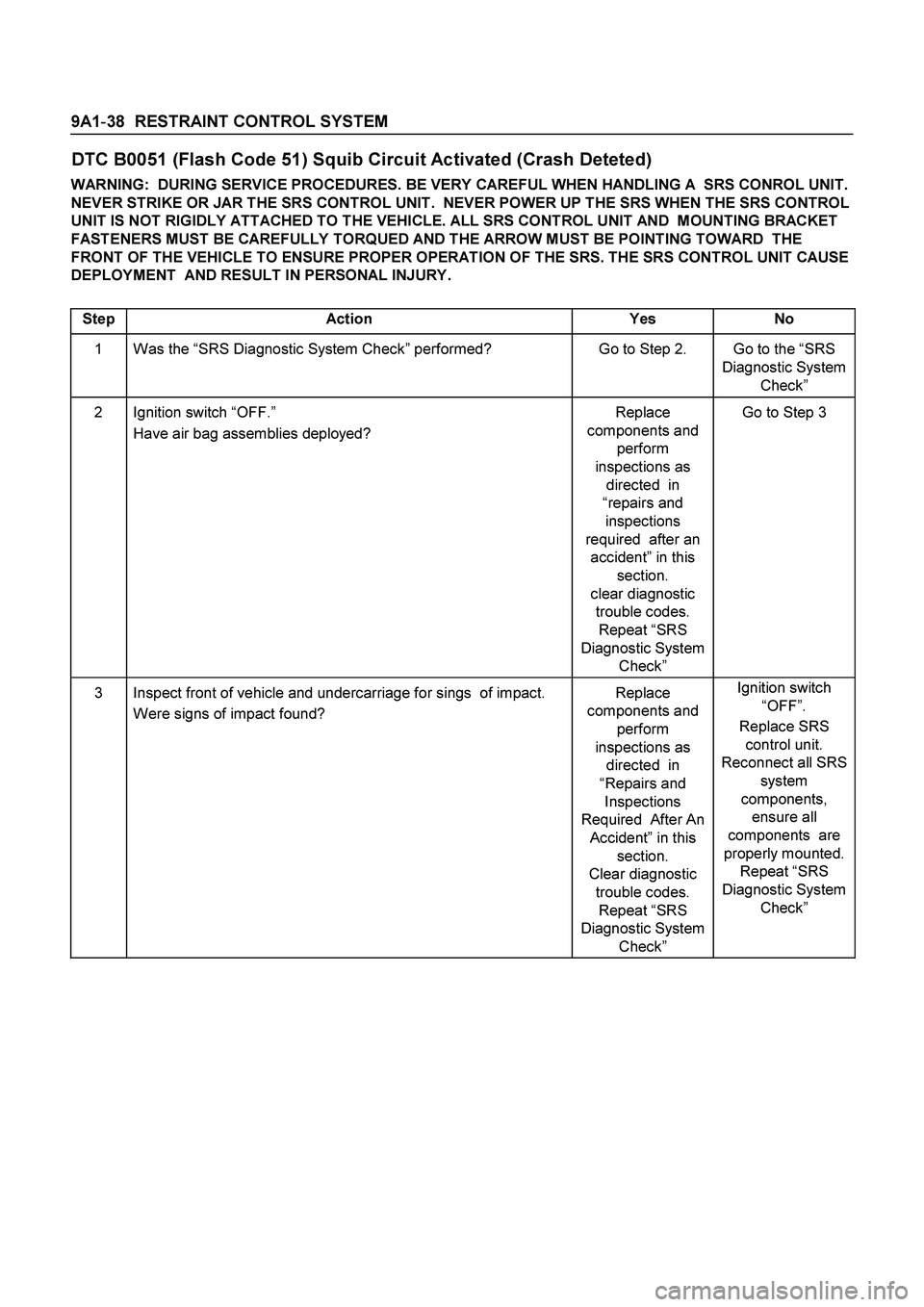
9A1-38 RESTRAINT CONTROL SYSTEM
DTC B0051 (Flash Code 51) Squib Circuit Activated (Crash Deteted)
WARNING: DURING SERVICE PROCEDURES. BE VERY CAREFUL WHEN HANDLING A SRS CONROL UNIT.
NEVER STRIKE OR JAR THE SRS CONTROL UNIT. NEVER POWER UP THE SRS WHEN THE SRS CONTROL
UNIT IS NOT RIGIDLY ATTACHED TO THE VEHICLE. ALL SRS CONTROL UNIT AND MOUNTING BRACKET
FASTENERS MUST BE CAREFULLY TORQUED AND THE ARROW MUST BE POINTING TOWARD THE
FRONT OF THE VEHICLE TO ENSURE PROPER OPERATION OF THE SRS. THE SRS CONTROL UNIT CAUSE
DEPLOYMENT AND RESULT IN PERSONAL INJURY.
Step Action Yes No
1 Was the “SRS Diagnostic System Check” performed? Go to Step 2. Go to the “SRS
Diagnostic System
Check”
2 Ignition switch “OFF.”
Have air bag assemblies deployed? Replace
components and
perform
inspections as
directed in
“repairs and
inspections
required after an
accident” in this
section.
clear diagnostic
trouble codes.
Repeat “SRS
Diagnostic System
Check” Go to Step 3
3 Inspect front of vehicle and undercarriage for sings of impact.
Were signs of impact found? Replace
components and
perform
inspections as
directed in
“Repairs and
Inspections
Required After An
Accident” in this
section.
Clear diagnostic
trouble codes.
Repeat “SRS
Diagnostic System
Check” Ignition switch
“OFF”.
Replace SRS
control unit.
Reconnect all SRS
system
components,
ensure all
components are
properly mounted.
Repeat “SRS
Diagnostic System
Check”
Page 110 of 4264
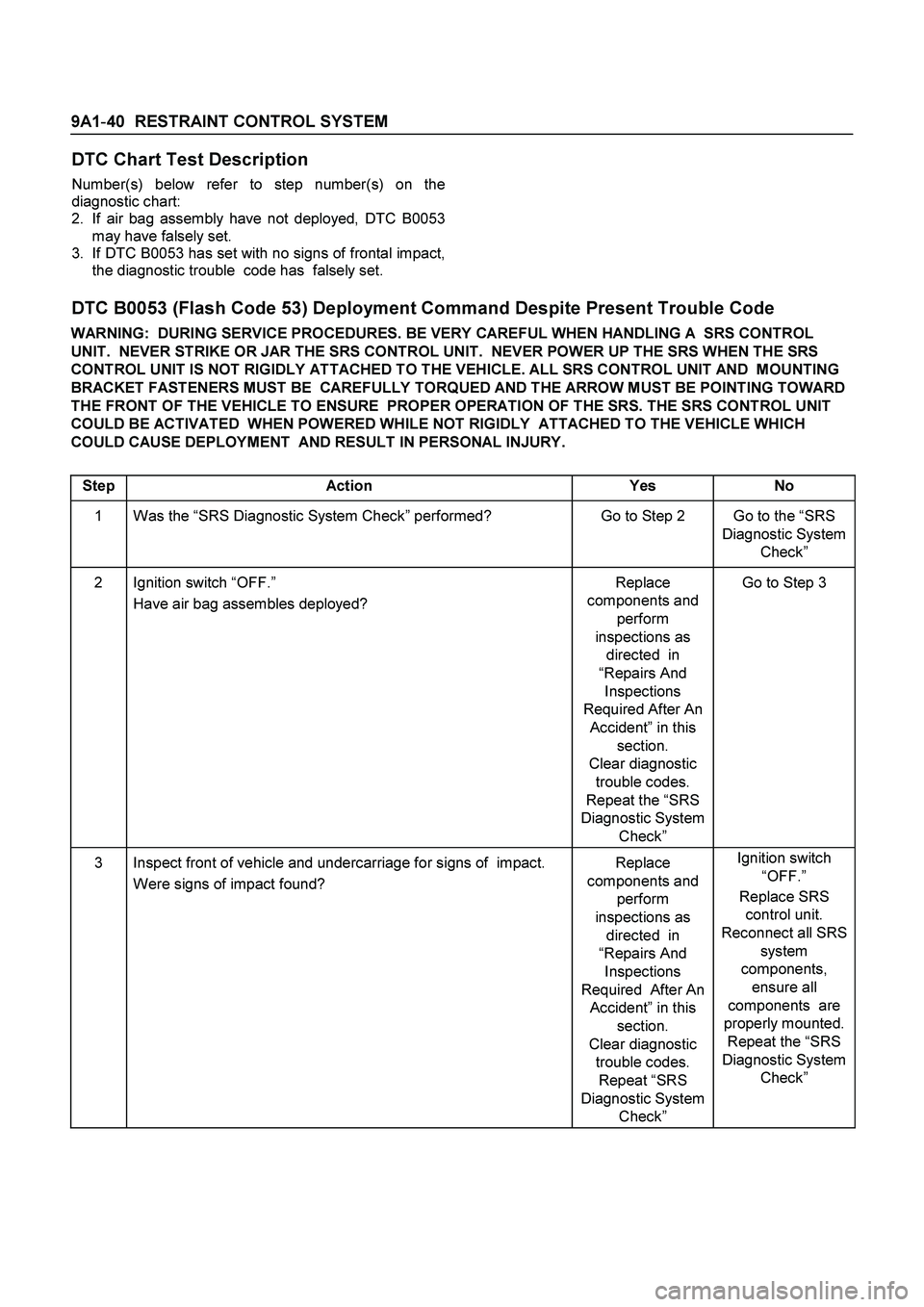
9A1-40 RESTRAINT CONTROL SYSTEM
DTC Chart Test Description
Number(s) below refer to step number(s) on the
diagnostic chart:
2.
If air bag assembly have not deployed, DTC B0053
may have falsely set.
3.
If DTC B0053 has set with no signs of frontal impact,
the diagnostic trouble code has falsely set.
DTC B0053 (Flash Code 53) Deployment Command Despite Present Trouble Code
WARNING: DURING SERVICE PROCEDURES. BE VERY CAREFUL WHEN HANDLING A SRS CONTROL
UNIT. NEVER STRIKE OR JAR THE SRS CONTROL UNIT. NEVER POWER UP THE SRS WHEN THE SRS
CONTROL UNIT IS NOT RIGIDLY ATTACHED TO THE VEHICLE. ALL SRS CONTROL UNIT AND MOUNTING
BRACKET FASTENERS MUST BE CAREFULLY TORQUED AND THE ARROW MUST BE POINTING TOWARD
THE FRONT OF THE VEHICLE TO ENSURE PROPER OPERATION OF THE SRS. THE SRS CONTROL UNIT
COULD BE ACTIVATED WHEN POWERED WHILE NOT RIGIDLY ATTACHED TO THE VEHICLE WHICH
COULD CAUSE DEPLOYMENT AND RESULT IN PERSONAL INJURY.
Step Action Yes No
1 Was the “SRS Diagnostic System Check” performed? Go to Step 2 Go to the “SRS
Diagnostic System
Check”
2 Ignition switch “OFF.”
Have air bag assembles deployed? Replace
components and
perform
inspections as
directed in
“Repairs And
Inspections
Required After An
Accident” in this
section.
Clear diagnostic
trouble codes.
Repeat the “SRS
Diagnostic System
Check” Go to Step 3
3 Inspect front of vehicle and undercarriage for signs of impact.
Were signs of impact found? Replace
components and
perform
inspections as
directed in
“Repairs And
Inspections
Required After An
Accident” in this
section.
Clear diagnostic
trouble codes.
Repeat “SRS
Diagnostic System
Check” Ignition switch
“OFF.”
Replace SRS
control unit.
Reconnect all SRS
system
components,
ensure all
components are
properly mounted.
Repeat the “SRS
Diagnostic System
Check”
Page 132 of 4264

9A1-62 RESTRAINT CONTROL SYSTEM
DTC B1000 (Flash Code 72) SDM Internal Fault (SDM=SRS control unit)
WARNING: DURING SERVICE PROCEDURES. BE VERY CAREFUL WHEN HANDLING A SRS CONTROL
UNIT. NEVER STRIKE OR JAR THE SRS CONTROL UNIT. NEVER POWER UP THE SRS WHEN THE SRS
CONTROL UNIT IS NOT RIGIDLY ATTACHED TO THE VEHICLE. ALL SRS CONTROL UNIT AND MOUNTING
BRACKET FASTENERS MUST BE CAREFULLY TORQUED AND THE ARROW MUST BE POINTING TOWARD
THE FRONT OF THE VEHICLE TO ENSURE PROPER OPERATION OF THE SRS. THE SRS CONTROL UNIT
COULD BE ACTIVATED WHEN POWERED WHILE NOT RIGIDLY ATTACHED TO THE VEHICLE WHICH
COULD CAUSE DEPLOYMENT AND RESULT IN PERSONAL INJURY.
CAUTION: If DTC B1000 can not clear by Tech2, it is necessary to replace the SRS control unit.
Step Action Yes No
1 Was the “SRS Diagnostic System Check” performed? Ignition switch
“OFF.”
Replace SRS
control unit.
Repeat the “SRS
Diagnostic System
Check” Go to the “SRS
Diagnostic System
Check”
Page 138 of 4264

4A-2 PROPELLER SHAFT
Service Precaution
WARNING: THIS VEHICLE HAS A
SUPPLEMENTAL RESTRAINT SYSTEM (SRS).
REFER TO THE SRS COMPONENT AND WIRING
LOCATION VIEW IN ORDER TO DETERMINE
WHETHER YOU ARE PERFORMING SERVICE ON
OR NEAR THE SRS COMPONENTS OR THE SRS
WIRING. WHEN YOU ARE PEREFORMING
SERVICE ON OR NEAR THE SRS COMPONENTS
OR THE SRS WIRING, REFER TO THE SRS
SERVICE INFORMATION. FAILURE TO FOLLOW
WARNING COULD RESULT IN POSSIBLE AI
R
BAG DEPLOYMENT, PERSONAL INJURY, OR
OTHERWISE UNNEEDED SRS SYSTEM
REPAIRS. CAUTION : Always use the correct fastener in the
proper location. When you replace a fastener,
use ONLY the exact part number for that
application. ISUZU will call out those fasteners
that require a replacement after removal. ISUZU
will also call out the fasteners that require thread
lockers or thread sealant. UNLESS OTHERWISE
SPECIFIED, do not use supplemental coatings
(Paints, greases, or other corrosion inhibitors)
on threaded fasteners or fastener joint
interfaces. Generally, such coatings adversely
affect the fastener torque and the joint clamping
force, and may damage the fastener. When you
install fasteners, use the correct tightening
sequence and specifications. Following these
instructions can help you avoid damage to parts
and systems.
Page 165 of 4264
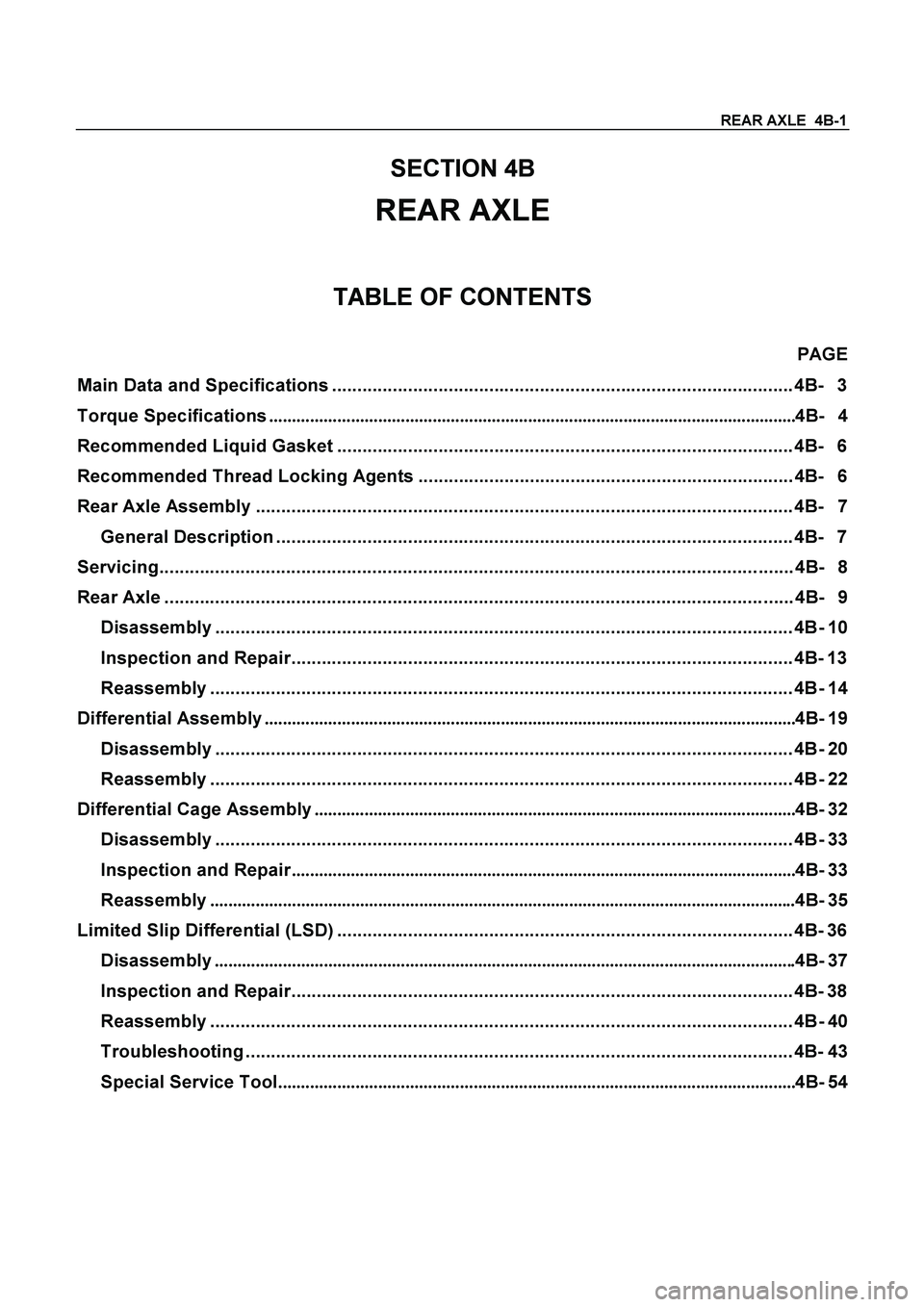
REAR AXLE 4B-1
SECTION 4B
REAR AXLE
TABLE OF CONTENTS
PAGE
Main Data and Specifications ........................................................................................... 4B- 3
Torque Specifications....................................................................................................................4B- 4
Recommended Liquid Gasket .......................................................................................... 4B- 6
Recommended Thread Locking Agents .......................................................................... 4B- 6
Rear Axle Assembly .......................................................................................................... 4B- 7
General Description ...................................................................................................... 4B- 7
Servicing............................................................................................................................. 4B- 8
Rear Axle ............................................................................................................................ 4B- 9
Disassembly .................................................................................................................. 4B- 10
Inspection and Repair................................................................................................... 4B- 13
Reassembly ................................................................................................................... 4B- 14
Differential Assembly.....................................................................................................................4B- 19
Disassembly .................................................................................................................. 4B- 20
Reassembly ................................................................................................................... 4B- 22
Differential Cage Assembly..........................................................................................................4B- 32
Disassembly .................................................................................................................. 4B- 33
Inspection and Repair...............................................................................................................4B- 33
Reassembly.................................................................................................................................4B- 35
Limited Slip Differential (LSD) .......................................................................................... 4B- 36
Disassembly................................................................................................................................4B- 37
Inspection and Repair................................................................................................... 4B- 38
Reassembly ................................................................................................................... 4B- 40
Troubleshooting ............................................................................................................ 4B- 43
Special Service Tool..................................................................................................................4B- 54
Page 166 of 4264

4B-2 REAR AXLE
Service Precaution
WARNING:
THIS VEHICLE HAS A SUPPLEMENTAL
RESTRAINT SYSTEM (SRS). REFER TO THE SRS
COMPONENT AND WIRING LOCATION VIEW IN
ORDER TO DETERMINE WHETHER YOU ARE
PERFORMING SERVICE ON OR NEAR THE SRS
COMPONENTS OR THE SRS WIRING. WHEN YOU
ARE REFORMING SERVICE ON OR NEAR THE
SRS COMPONENTS OR THE SRS WIRING, REFE
R
TO THE SRS SERVICE INFORMATION. FAILURE
TO FOLLOW WARNINGS COULD RESULT IN
POSSIBLE AIR BAG DEPLOYMENT, PERSONAL
INJURY, OR OTHERWISE UNNEEDED SRS
SYSTEM REPAIRS.
CAUTION:
Always use the correct fastener in the prope
r
location. When you replace a fastener, use ONLY
the exact part number for that application. ISUZU
will call out those fasteners that require a
replacement after removal. ISUZU will also call out
the fasteners that require thread lockers o
r
thread sealant. UNLESS OTHERWISE SPECIFIED,
do not use supplemental coatings (Paints,
greases, or other corrosion inhibitors) on threaded
fasteners or fastener joint interfaces. Generally,
such coatings adversely affect the fastener torque
and the joint clamping force, and may damage the
fastener. When you install fasteners, use the
correct tightening sequence and specification.
Following these instructions can help you avoid
damage to parts and systems.